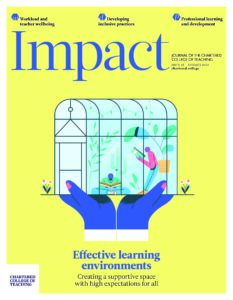Students’ perceptions of oracy: Implications for schools

Victoria Cook, Laura Guihen and Amy Gaunt, Voice 21, UK
This article draws on a growing evidence base illustrating the positive difference that oracy education makes to children and young people’s outcomes and opportunities. We explore students’ perceptions of oracy, drawing on data collected from 1,994 primary and secondary students across England who had undertaken a programme of oracy teaching and learning for one to three years as part of the Voice 21 Oracy Schools programme.
What is ‘oracy’ and why do we need it?
The term ‘oracy’ was coined in 1965 by professor of education Andrew Wilkinson, who recognised that speaking and listening should be placed on an equal footing with numeracy and literacy. Oracy may be understood as both a set of teachable skills and a pedagogy; the best oracy teaching and learning occurs when students are learning through talk while simultaneously learning the skills required to talk effectively (Gaunt and Stott, 2019). Oracy involves both presentational talk, such as that associated with public speaking or debating, and ‘exploratory talk’, in which students engage in reasoned discussions (Dawes et al., 2000).
Oracy teaching has significant implications for students’ cognitive, social and emotional outcomes. It has been demonstrated that classroom talk has a measurable impact on attainment across a range of subjects, including English, science and maths (Jay et al., 2017), and has a positive impact on literacy (Dockrell et al., 2015) and reasoning skills (Mercer et al., 1999). Further impacts on students’ social and emotional outcomes include the development of empathy, self-confidence and resilience (APPG, 2021).
Moreover, students from less advantaged backgrounds are likely to experience the greatest impacts of oracy teaching. For example, Gorard et al. (2015) reported the greatest positive impacts on Key Stage 2 attainment among students eligible for free school meals. Oracy teaching may also help to narrow the ‘language gap’ between less advantaged students and their more advantaged peers, which is particularly pertinent in the wake of COVID-19 (Menzies et al., 2020).
Given this compelling evidence base, a focus on building oracy-rich classrooms, in which students have opportunities to express themselves and learn both to and through talk, is vital. However, classrooms are complex spaces, and we cannot take students’ experiences for granted. It is imperative, therefore, that we listen to what students themselves have to say about oracy and use these insights to help to build a supportive environment in which all students feel that their voice is valued.
Data collection and data analysis
Schools that become Voice 21 Oracy Schools are part of a national network committed to providing a high-quality oracy education. To understand and evaluate schools’ oracy provision, both staff and a sample of students complete an online survey. This article focuses on the results of a student survey conducted in the summer term of 2021. Specifically, we focus on students’ free-text responses to the question: ‘Is there anything else you would like to say about why speaking and listening (oracy) is important?’
A total of 195 schools across England and Wales took part. Two-thirds of participating schools were primary schools, with the remaining third comprising secondary schools and other providers. Overall, 2,210 student comments were received from children in every year group from EYFS to Year 11. The majority of responses (68 per cent), however, came from students in Years 5 to 8.
Removing blank or off-topic comments left 1,994 responses to analyse. Thematic analysis (Braun and Clarke, 2006) was used to capture patterns across responses and commonalities of opinion. After inductively generating codes, as well as searching for, reviewing and naming themes across the dataset, we arrived at a final set of themes. These are explored below.
Students’ perceptions of oracy
Classroom culture
Students told us that they appreciate the time, freedom and space to express themselves and their opinions in class:
Speaking and listening is important because when children talk they feel respected and cared for when other people listen.
I like oracy because it’s great when everyone listens. People don’t laugh at you and they listen without interrupting.
Oracy allows people to share their opinions. Don’t hold back on what you want to say, share how you feel about the subject of a discussion, just be sure to express it in a polite and respectful way.
Our analysis suggests that students value the creation of a safe and supportive environment in which people listen and do not ridicule each other. This supportive environment is underpinned by a classroom culture in which every student feels that what they have to say matters:
I think that I am sometimes ignored when i speak also when I am listend to my opion is sometimes forgotten however the school makes up for this because when I am listend to and my opinion is not forgotten it gives me a GREAT feeling inside. (sic)
I love oracy because that’s when I can share my opinion and people will listen. Also it is really fun to listen to what other people’s perspective is on a topic.
This classroom culture supports the sharing of ideas for others to probe, build on or challenge as students learn to think together. However, such a culture takes time to develop, and some students may remain reluctant to share their ideas for fear of being ‘wrong’:
i think speaking infront of class mates is embarasing because of if you get it wrong and i think its a bit… awkward when everyone is looking at you for an answer. (sic)
When I say a answer, I sometimes think I get it wrong and I get scared if any people make fun of me or laugh if I get it wrong.
A culture in which students feel able to share incorrect or partially formed ideas is therefore vitally important if talk is to flourish.
Empowering voice
Students perceive oracy to be empowering, helping them to find their voice. Here, ‘voice’ refers to both the right of students to express their ideas and the obligation of others to listen and treat them with respect (Alexander, 2020). They expressed a sense of pride in using their voice, which they viewed as a tool for self-expression:
Oracy helped me express the person I am today. I managed to find my voice and use it.
I like speaking, my voice is an instrument.
Knowing you’re being listened to is extremely empowering.
I feel that speaking and listening is important because it’s a human right to have a say.
However, if voice entails the right to talk, it also entails the right to remain silent:
People have a right to talk just as much as they have the right to remain silent. It’s a human right.
Thinking about if, and when, it is appropriate to ask individuals to contribute depends on teachers’ knowledge of their students and the sensitivity of the topic being discussed. It is also important to consider how teachers can support other students who find talking in class ‘scary’, ‘nerve-wracking’ or ‘stressful’. For such students, talking can trigger physical symptoms of anxiety or tap into feelings of self-doubt:
I do not like speaking to any audience as I am very shy and get nervous.
It makes me feel nervous because lots of people are looking at me. It makes my tummy turn.
Students’ confidence may vary according to context. Students often said that they like talking to their friends or in small groups, but do not enjoy talking with people they don’t know or in front of the whole class:
I only speak to my friends but not other people.
I am better at speaking to the class but I still do not enjoy it. I like talking in a small group.
Taking students’ perceptions into account, we will now discuss practical steps that teachers can take to build a classroom culture in which students feel both comfortable and empowered to use their voice.
Nurturing oracy
Establishing a shared understanding of oracy is an important first step towards developing a classroom culture in which oracy thrives. Without this, students may struggle to understand what is expected of them, causing unnecessary anxiety. The Oracy Framework (Voice 21 in conjunction with University of Cambridge, 2015) is a useful tool for articulating expectations for oracy in different contexts. When addressing the class, for example, you might encourage students to consider the ‘physical’ strand of the Framework by speaking loudly and clearly enough for the whole class to hear.
Exploratory talk is a particularly powerful context for talk in the classroom, providing students with the opportunity to share their opinions and engage with those of others. Creating discussion guidelines or ‘ground rules’ for talk (Dawes et al., 2000) with students – essentially a set of success criteria for effective discussion – can contribute to the development of a supportive classroom culture. As part of these guidelines, you could, for example, state that students should invite others to contribute or build on each other’s ideas. This sets a powerful precedent; the success of a discussion relies on how students construct meaning together, as a group, rather than on individual contributions. For a quieter student, simply being asked their opinion may be enough to make them feel that their voice is valued and encourage them to contribute.
Exploratory talk, during both whole-class and small-group discussion, is often ‘hesitant and incomplete because it enables the speaker to try out ideas, to hear how they sound, to see what others make of them’ (Barnes, 2008, p. 5). As a teacher, it is important not to have unrealistic expectations for this type of talk; instead, model sharing partially formed ideas and encourage students to build on, develop or challenge these and praise them when they do.
When moving towards more polished, presentational contexts for talk, isolate the skills that students need to perform well in this context and teach them explicitly. If you are focusing on speaking to an audience, provide students with opportunities to speak in front of a smaller, familiar group initially, before working towards a larger audience.
Conclusion
Our findings suggest that a focus on oracy helps to build a supportive learning environment in which students feel that they have the right to speak and be heard. However, it is important that teachers intentionally foster this culture, to overcome potential barriers of anxiety, embarrassment and a reluctance to participate and to ensure that every student finds their voice.
Voice 21 offers chargeable services to schools.
- Alexander R (2020) A Dialogic Teaching Companion. London: Routledge.
- Barnes D (2008) ‘Exploratory talk for learning’. In: Mercer N and Hodgkinson S (eds) Exploring Talk in School Inspired by the Work of Douglas Barnes. London: SAGE Publications, pp. 1–16.
- Braun V and Clarke V (2006) Using thematic analysis in psychology. Qualitative Research in Psychology 3(2): 77–101.
- Dawes L, Mercer N and Wegerif R (2000) Thinking Together: A Programme of Activities for Developing Speaking, Listening and Thinking Skills, for Children Aged 8–11. Birmingham: Imaginative Minds.
- Dockrell JE, Marshall C and Wyse D (2015) Talk for Writing: Evaluation report and executive summary. Education Endowment Foundation. Available at: https://d2tic4wvo1iusb.cloudfront.net/documents/projects/EEF_Project_Report_TalkForWriting.pdf?v=1630925963 (accessed 15 March 2022).
- Gaunt A and Stott A (2019) Transform Teaching and Learning Through Talk: The Oracy Imperative. Lanham, Maryland: Rowman and Littlefield.
- Gorard S, Siddiqui N and Huat See B (2015) Philosophy for Children: Evaluation report and executive summary. Education Endowment Foundation. Available at: https://d2tic4wvo1iusb.cloudfront.net/documents/projects/EEF_Project_Report_PhilosophyForChildren.pdf?v=1630926028 (accessed 15 March 2022).
- Jay T, Willis B, Thomas P et al. (2017) Dialogic teaching: Evaluation report and executive summary. Education Endowment Foundation. Available at: https://d2tic4wvo1iusb.cloudfront.net/documents/projects/Dialogic_Teaching_Evaluation_Report.pdf?v=1630925826 (accessed 15 March 2022).
- Menzies L, Millard W, Yeeles P et al. (2020) Bridging the word gap at transition: The Oxford Language Report 2020. Available at: https://cfey.org/reports/2020/10/bridging-the-word-gap-at-transition (accessed 7 November 2021).
- Mercer N, Wegerif R and Dawes L (1999) Children’s talk and the development of reasoning in the classroom. British Educational Research Journal 25: 95–111.
- Oracy All-Party Parliamentary Group (APPG) (2021) Speak for Change: Final report and recommendations from the Oracy All-Party Parliamentary Group Inquiry. Available at: https://oracy.inparliament.uk/sites/oracy.inparliament.uk/files/2021-04/Oracy_APPG_FinalReport_28_04%20%284%29.pdf (accessed 7 November 2021).
- Voice 21 in conjunction with University of Cambridge (2015) The Oracy Skills Framework and glossary. Available at: https://oracycambridge.org/wp-content/uploads/2020/06/The-Oracy-Skills-Framework-and-Glossary.pdf (accessed 13 December 2021).
- Wilkinson A (1965) The concept of oracy. Educational Review 17(4): 11–15.










